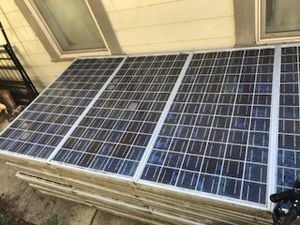Background
The Campus Center for Appropriate Technology located on Humboldt State University in California has an extra amount of solar panels but they are unsure what to use them for. As a team we will attempt to construct some kind of solar bug out box to help students when black outs occur. This bug out box will need to be mobile and be able to charge batteries which students can then use for whatever they need.

Problem statement=
The objective of this project is to create an easily digested bug out box made with solar panels from ccat. This box will harness photovoltaic energy so that the users can charge various devices and possibly run appliances. As a group we hope that we can make a box that is easily remade with simple instructions that creates enough usable energy to be a reasonable alternative to using a car battery during a time of no power.
Literature Review
This is a review of the available literature pertinent to the a specific project.
Solar Power basics
A simple photovoltaic(PV) system consists of one or more solar panels(a solar array), a charge controller and a battery or battery bank. While the sun hits the solar panels, those panels turn energy from the sunlight into direct current(DC) electricity which is then stored in the battery. The charge controller regulates the flow of electricity to and from the battery, preventing the electricity from flowing out of the battery back to the solar array as well as preventing overcharging of the battery. An inverter may be required to convert the electricity from DC to AC(Alternating Current) depending on what is being powered.Cite error: Closing </ref> missing for <ref> tag
Solar Power concerns
The biggest problem with solar power is the fact that it will not generate any electricity without sunlight. A PV system will produce minimal to no power during nights, cloudy days and in shaded areas. Solar energy may not be the right answer for an individuals energy needs if they are in an area with limited exposure to sunlight. Solar panels have limited efficiency as well, with the most efficient solar panel converting roughly 22% of energy from sunlight into usable energy. Most solar panels fall within a 16-20% efficiency range. [1]
Components of Solar Power
In depth information about the different components of a photovoltaic system and what we will use for our project. [2]
Solar Panels
Solar panels are composed of many individual cells called solar cells. Solar cells are composed of semiconductor materials which generate energy when light hits the cell, the sum of which is the total energy produced by the panel. [3] The ability of a solar panel to convert sunlight into usable energy is called its efficiency, which ranges from 15% to nearly 23%.
Batteries
Depending on the individuals energy needs, different sizes of batteries will be required. For a bug out box [2]
Load
Type 3 composting is a system that utilizes..... Make sure to include description, advantages and disadvantages, and/or have a comparison matrix.
Environment
Designing interpretive materials
According to ______ interpretive materials for composting should include....
References
- ↑ Clean Energy Reviews
- ↑ 2.0 2.1 This is an example of a named reference. You can use these named references to repeat citation content throughout the document.
- ↑ https://science.nasa.gov/science-news/science-at-nasa/2002/solarcells/